The general term “horses” covers a lot of different types – lots of sizes, colors, and even shapes. Pretty much every equine-looking animal has been called “horse” at some point. While most know that there are several breeds of horses, did you know that those breeds all fall into classifications of their own?
Here are the seven most common types of horses and the breeds of horses that correspond with each type.
| Horse Types | Main Characteristics | Breed Examples |
| Ponies | Shorter than 14.2 hands tall. Separate (though related) species froma horse | Shetland, Welsh, Highland, Dartmoor |
| Gaited Horses | Selectively breed for smooth, atypical, four-beat gaits | Tennessee Walking Horse, Paso Fino, Campeiro, Standardbred |
| Hot-Blooded Horses | Intelligent, fiery personalities. Refined, elegant physical attributes | Thoroughbred, Arabian, Akhal-Teke |
| Warmbloods | Milder, more level-headed personalities | Hanoverian, Holsteiner, Dutch Warmblood |
| Draft Horses (Cold-Blooded) | Large, sturdy, even-tempered and bombproof | Clydesdale, Percheron, Shire Horse, Belgian |
| Light-Horses | Bred for light work. Medium-sized and of mid-weight. | Lipizzaner, Hanoverian, Arabian, Morgan |
| Horse Hybrids | Varies depending on the cross. Strips for Zorse’s and Long Ears for Mules | Zorse, Mule |
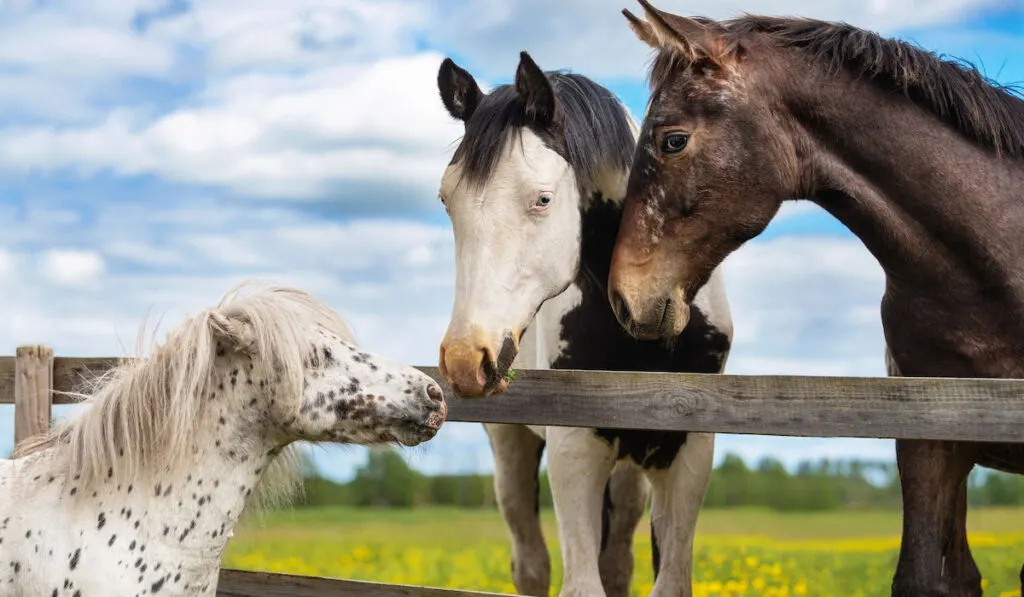
There are seven common types of horses – all with their own defining qualities and characteristics. Each different type of horse has several breeds, too, that fall in their classifications.
- Ponies
- Gaited Horses
- Hot-Blooded Horses
- Warmblood Horses
- Draft Horses
- Light Horses
- Hybrids
Let’s take a look at seven types – ponies, gaited horses, hot-blooded horses, warmbloods, draft horses, light horses, and hybrids.
Table of Contents
Ponies
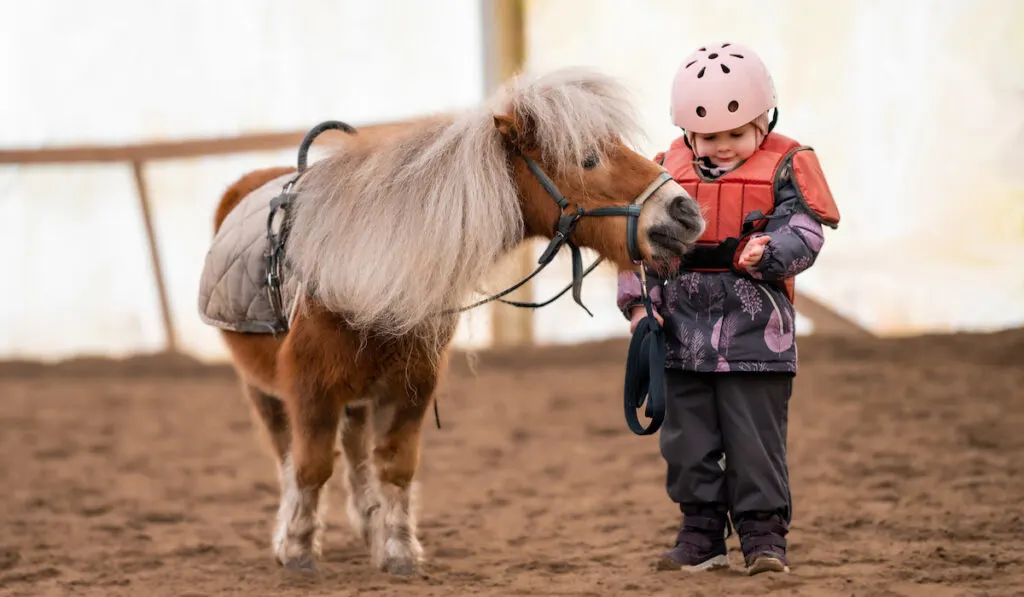
What is a pony?
The first thing most people think of as a defining characteristic of a pony is its size, and that’s a very good way to distinguish them! By definition, a pony stands no taller than 14.2 hands high.
However, similar to the old saying “all elephants are gray but not all gray things are elephants”, while all ponies are under 14.2 hands high, some horses are as well.
So all ponies are equines that are shorter than 14.2 hands, but not all equines shorter than 14.2 hands are ponies.
For example, miniature horses and Icelandic horses are all quite short – well under 14.2 hands, in fact – but they are still classified as horses (or miniature horses) and are not ponies.
It’s important to note that ponies truly are their own type of horse. A pony isn’t a baby horse or a small horse. They will stay small, even when fully grown.
They may be compact, but their sturdiness and stockiness in one small package also make ponies well known for their strength and endurance.
They can generally work hard and travel long distances without needing a break better than many of their larger relatives, thanks to their hearty builds.
This stocky build also means they are stronger, pound for pound than larger horses. The ratio of strength to bodyweight is greater in ponies.
Looking at a pony you would note its shorter legs, thicker mane, coat and tail, wider chest and heavier bones than a regular horse. They also have thick, strong necks and heads that are more short and compact. Their bodies though are very proportionate.
Pony Temperament
Like any animal, ponies can have a wide array of personalities. What’s interesting is that two of their most commonly associated traits sound like they should be at odds with one another: gentleness and stubbornness!
Ponies tend to be sweet and loving, particularly to their owners and young riders. However, they can also have a streak of Napoleon complex and can be temperamental and pretty stubborn, too.
Ponies are also likely to be tolerant of colder climates and harsher winters. Since they have thicker bodies and coats, they don’t feel the cold as much as larger horse breeds.
This also means they are more willing to work even in the cold and have an overall more consistent temperament in the winter.
Common Pony Breeds
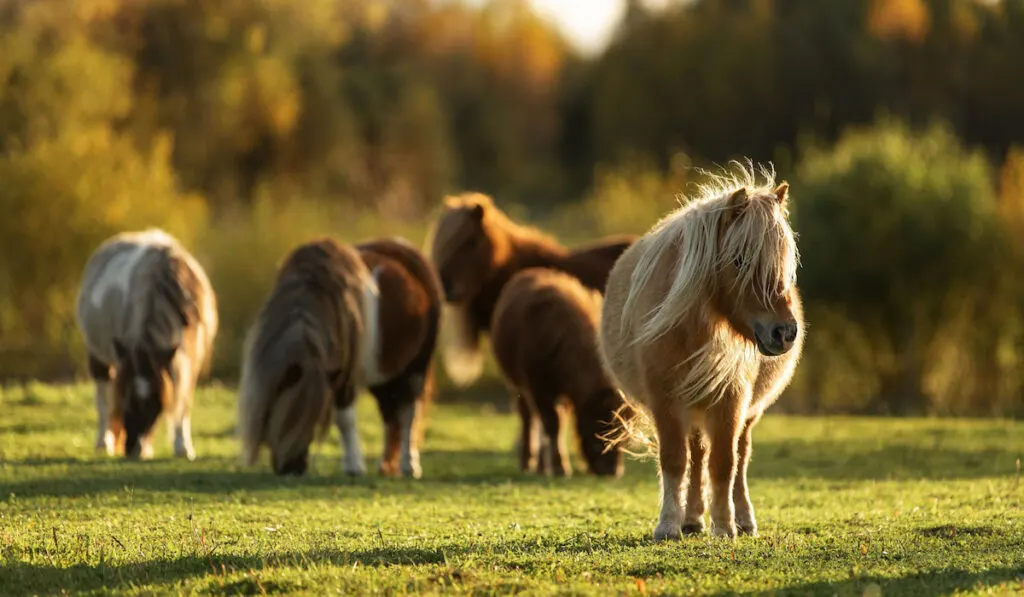
There are many different purebred pony breeds. These are just a few of the more popular ones.
- Shetland Pony. This famous breed of pony originated in the Shetland Isles in Scotland. Their even temperament and intelligence, combined with their short stature, makes them a popular mount for children.
- Pony of the Americas. The Pony of the Americas, commonly called POA, is a breed of pony developed entirely in the United States. Known for their spotted coats, these colorful ponies almost always have pronounced Appaloosa coloring.
- Chincoteague Pony. Made famous by the classic book, Misty of Chincoteague, these ponies roam wild on Assateague Island in Virginia and Maryland. This pony breed is gathered regularly and offered for adoption. You can read more about that in my article on the types of wild horses in the United States.
- Dartmoor and Exmoor Ponies. The Dartmoor and Exmoor ponies are native to English where they roam wild. These pony breeds are very popular in Europe and often trained for children to ride.
- Connemara Pony. The connemara pony is very popular, especially in the English show arena where they make excellent mounts for the children’s over fence classes. This pony breed originated in Ireland and they are known to have good temperaments and be easily trainable.
- Miniature Horses. The miniature horse breed falls into the realm of ponies in terms of height because they are small in stature. They maintain the overall appearance of a large-sized horse in a small horse’s body. Miniature horses are typically between 34 inches and 38 inches high.
- Haflinger. The Haflinger horse breed is known to be hardworking and versatile. This type of horse is generally mistaken for a Palomino however all members of the breed are gorgeous flaxen chestnuts. There are two types of Haflinger horses, a draft-type pony that is great for pack use and a light-type that excels at riding.
Gaited Horses
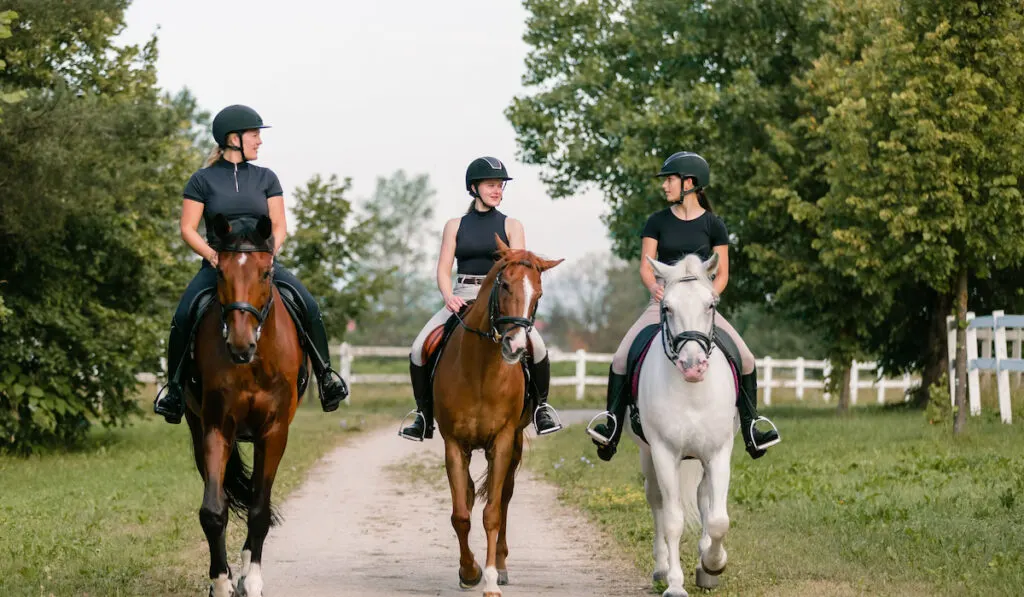
What are gaited horses?
Gaited horses are the product of selective breeding; a.k.a. human interference with a purpose. They were developed by breeding only certain horses that had natural “gaited” abilities.
That is, they have gaits landing outside the traditional walk, trot, and canter that make for a smooth ride, are of medium speed and follow a four-beat rhythm. These are commonly called ambling gaits.
Given that they are selectively bred (but not artificially produced), gaited horses have a dominant gene responsible for their trademark ambling gait.
Because these gaits are most often the result of genetics, some horses can be carriers but not necessarily demonstrate the gene themselves.
Not every horse from a breed typically associated with gaited horses will exhibit the ambling gait. Some horses also have a naturally lighter trot and can learn an ambling gait with training, though this does not make them considered gaited horses.
Qualities of Gaited Horses
A gaited horse is often sought after for a smooth ride. Riding one is also more energy-efficient, as there is less energy required than a lofty trot. Because of this conserved energy, gaited horses tend to have more natural stamina and endurance than other horses who exhibit a traditional, bouncier trot.
Gaited horses were often developed to be saddle horses due to their smooth ride. As such, they are typically well mannered and easily trained.
Common Gaited Horse Breeds
In order to be considered a gaited horse, the horse just needs to have at least one gait outside of the normal walk, trot, canter, and gallop. The horse doesn’t even have to be purebred. There are, however, several breeds of horse whose members are naturally gaited.
These are a few of the most common gaited horse breeds.
- American Saddlebred. Also known as Kentucky Saddlers, the American Saddlebred was developed in the United States. They excel at riding and driving. Members of this breed typically have five gaits. Learn more about this fun breed in my post with 15 fun American Saddlebred Facts.
- Tennessee Walker. The Tennessee Walker was created in the hills of Tennessee by mixing a wide variety of gaited and non-gaited horses to ultimately create the ultimate gaited horse. In fact, the founding sire of the breed could perform 7 different gaits on command!
- Icelandic Horse. Native to Iceland, these horses are short in stature (in fact, usually they are “pony” sized), and big in personality. They can perform many different gaits including the tölt which they are most well known for.
- National Show Horse. The cross between a purebred Arabian and an American Saddlebred is a National Show Horse. Members of this breed tend to not only inherit refining characteristics from the Arabian, but they also often inherit the high stepping gait of the American Saddlebred. As their name suggests, they are extremely popular show horses.
For a list of the different types of gaits and more information on gaited horse breeds, check out my post What is a Gaited Horse.
Hot Blooded Horses
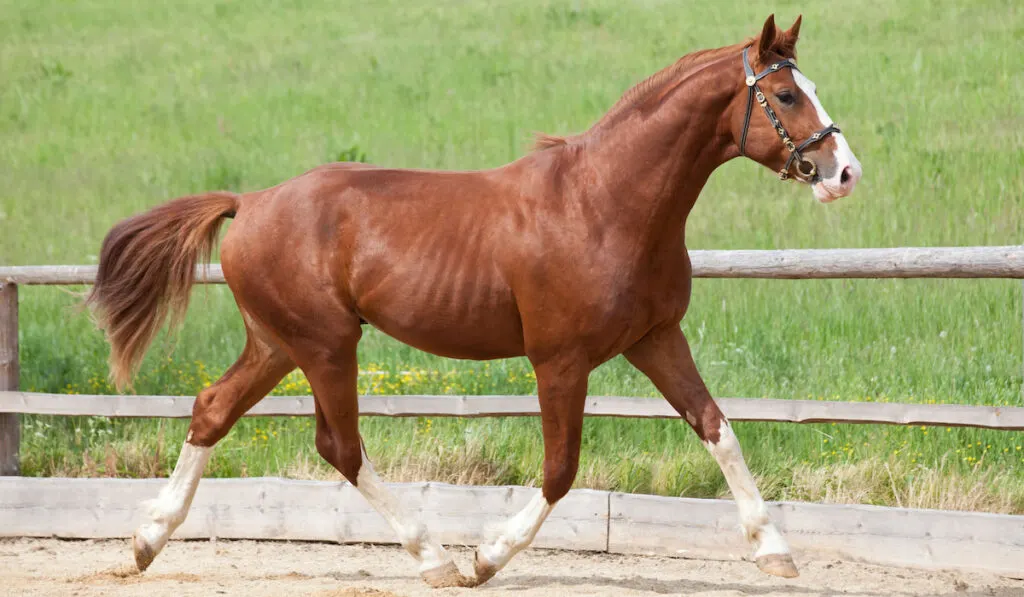
What makes a horse hot-blooded?
The term “hot-blooded” is more informal than scientific and describes different breeds with an energetic temperament and more high strung attributes. (source)
These are the horses that are quick to react, can be spooky or sensitive, and may be quick to throw themselves into a situation.
You often find speed and boldness in hot-bloods, but you can also get horses with a tendency to be tense and flighty.
Physical Attributes of Hot Blooded Horses
As they are based more on personality first instead of physicality, hot-blooded horses don’t always have one defining “look” that is genetically set in stone.
That said, they are never draft horses, and are more of average height. They are typically taller than ponies but smaller than drafts.
Hot blooded horses generally have a more refined look with slim bodies, light bones, long legs, high withers, thin skin, and a silky coat.
Hot blooded breeds have their origins in the Middle East, and have characteristics suited to the desert. They are naturally not only thinner skinned and thinner coated, but they also have less natural fat stores. This makes them more vulnerable to cold weather than other horses.
They also often have high metabolisms, giving some (especially Thoroughbreds) a “ribby” appearance. Despite their smaller frame, they may need more food than you would think, especially if they are being exercised regularly.
Hot-Blooded Horse Temperaments
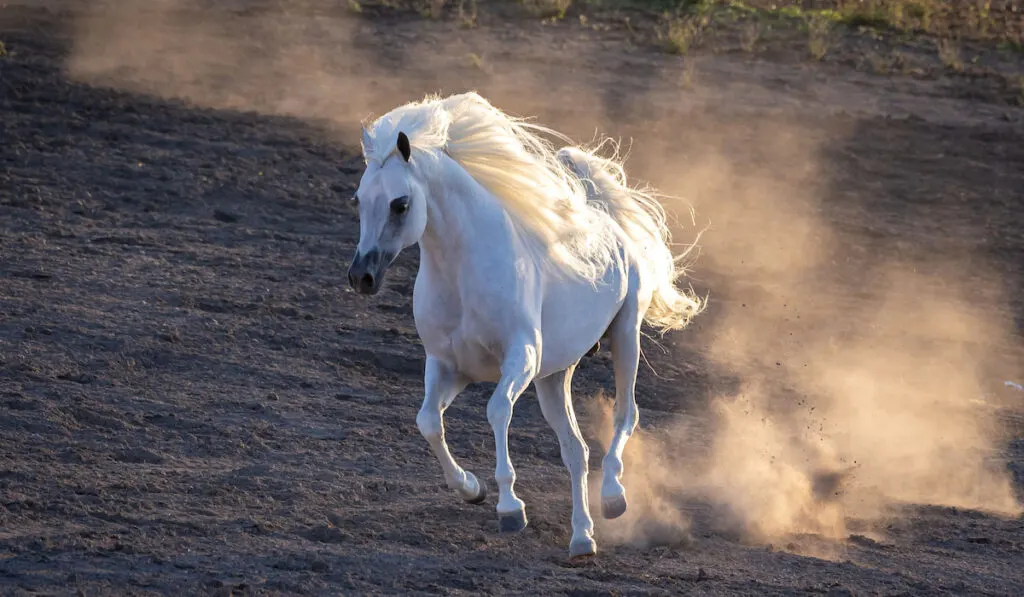
What really determines a hot-blooded horse is its personality and temperament. That’s why traditionally high strung and feisty horses, such as Thoroughbreds and Arabians, are the most commonly associated breeds with the hot-blooded distinction.
Because of their lighter build and faster reflexes, hot-bloods are highly athletic. You will often see them in racing, from traditional flat races to steeplechase events. These breeds are also sought after for eventing because of their speed and boldness cross country.
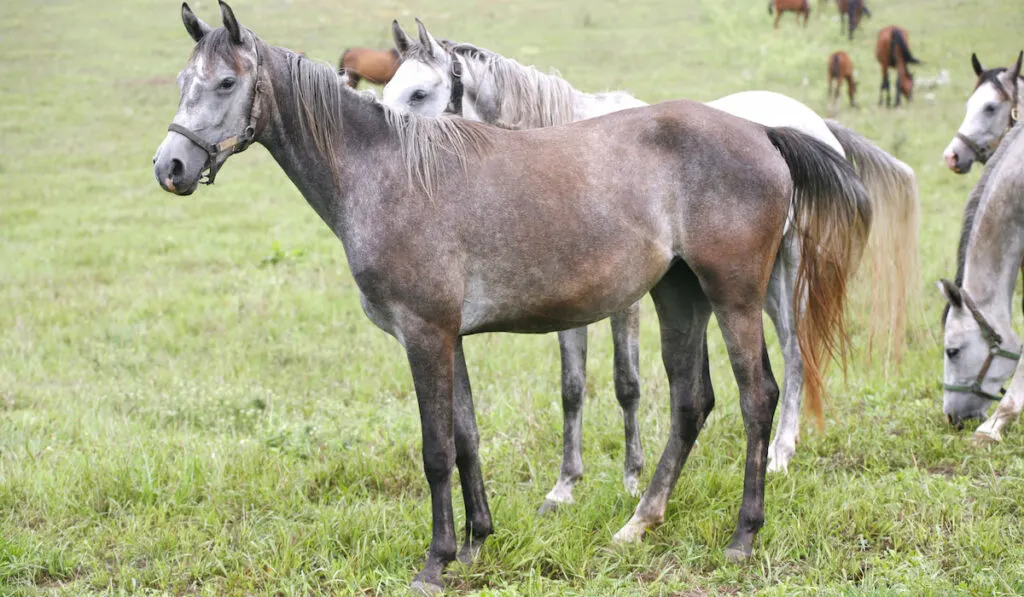
All that nervous energy, though, does make these refined horses quick learners. Because they are always at the ready, they are always thinking, and are considered some of the most intelligent horses.
They are quick to react and always on alert, but bond exceptionally well with humans. Typically, an experienced rider is recommended for a hot-blooded horse.
Hot-Blooded Horse Breeds
The two most commonly referenced breeds to be hot-blooded are the Arabian and the Thoroughbred but those aren’t the only hot-blooded horse breeds.
Here are a few types of horses considered to be hot-blooded.
- Arabian. Popularized by the novel, The Black Stallion by Walter Farley, the Arabian horse is one of the oldest horse breeds. Members of this beautiful breed typically have a refined, dished head that makes them immediately recognizable. They aren’t just a pretty face though, these horses excel in many disciplines including racing, english and western events.
- Thoroughbred. Like the Arabian, the Thoroughbred is one of those breeds that households across the world are familiar with, even if they don’t know horses. Bred for speed, these horses are most known for their prowess on the race-track but they excel in the show ring as well.
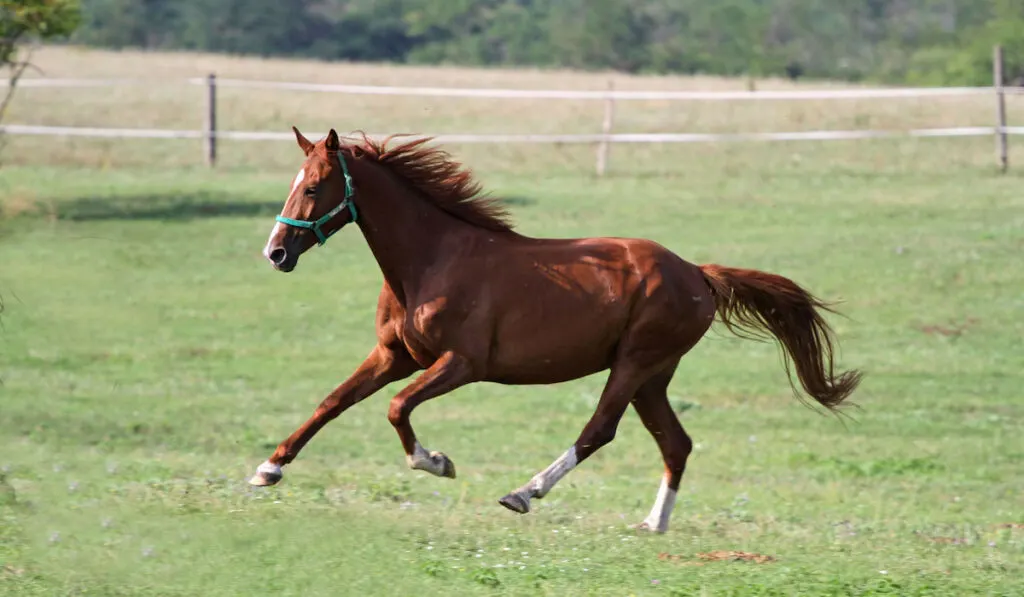
- Anglo-Arabian. Also called an “Anglo-Arab”, the first generation of this breed (F1) is typically created by crossing a purebred Arabian with a purebred Thoroughbred. The result is a versatile horse that typically exhibits the speed and strength of a Thoroughbred and the beauty and endurance of the Arabian.
- Barb. The Barb is a foundation breed on which many other breeds, such as the Thoroughbred and Quarter Horse were founded. More plain in appearance than it’s Arabian counterpart, the Barb’s endurance, stamina, and hardiness makes it an ideal mount in the harsh continent of Africa where the breed is believed to have originated.
- Akhal-Teke. A descendant of the Turkoman horse, the Akhal-Teke is most commonly known for the metallic sheen many of its members possess. Aside from their astoundingly bright color, this breed is well known for its endurance and excels at long-distance competitions.
Cold-Blooded Horses (Draft Horses)
Definition of a Draft Horse
Though most often referred to as draft horses, these type of horse can also be categorized as “cold-blooded.” This doesn’t mean they are reptilian and not mammalian, though – it simply refers to their cool and calm temperament.
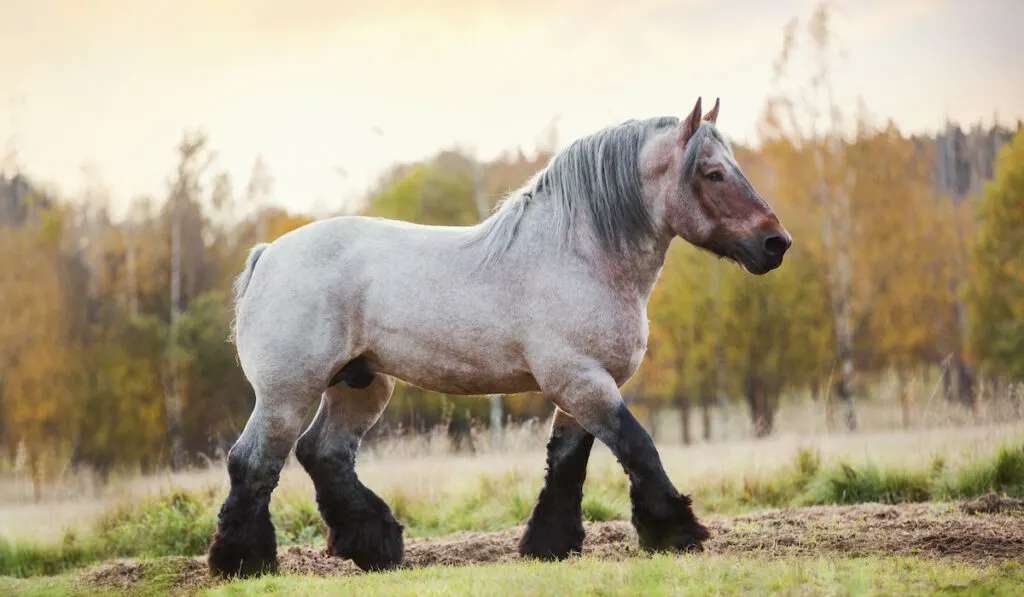
Physical Attributes of Cold-Blooded Horses
These horses were bred for heavy workloads and for agriculture. You will always find a draft horse to be large, both in height and in heft.
Draft horses typically stand between 16 and 19 hands, though typically run at the upper end, around 17 hands and up. Some even stand taller than 19 hands. They also generally weigh around 1,600 – over 2,00 pounds – a literal ton of horse!
Because of their large bodies, thick bones, and coarse coat (sometimes including extra “feathering” on their legs), draft horses are pretty much designed to thrive in the cold weather or in harsh conditions.
While most members of this type are tall, there are a handful of cold-blooded horse breeds that are more in the smaller range when it comes to height.
Cold-Blooded Horse Temperament
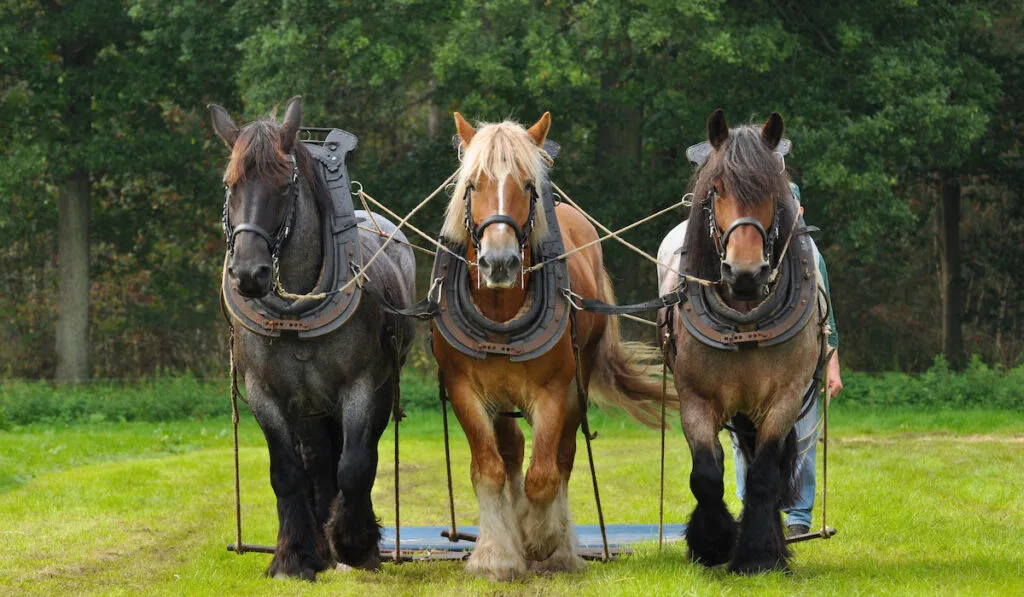
Commonly called “gentle giants” for a reason, draft horses are big, lovable teddy bears. They may look imposing but they are known for being calm, sweet, thoughtful and incredibly patient. Though their size may suggest otherwise, they are actually excellent horses for beginners, thanks to their even-tempered personalities.
Thanks to their strength and patience, cold-blooded horses are well-suited for pulling and hauling anything from carts to wagons to plows – they even compete in driving competitions.
People also love working with them as riding horses, since they are safe and calm mounts.
Common Draft Horse Breeds
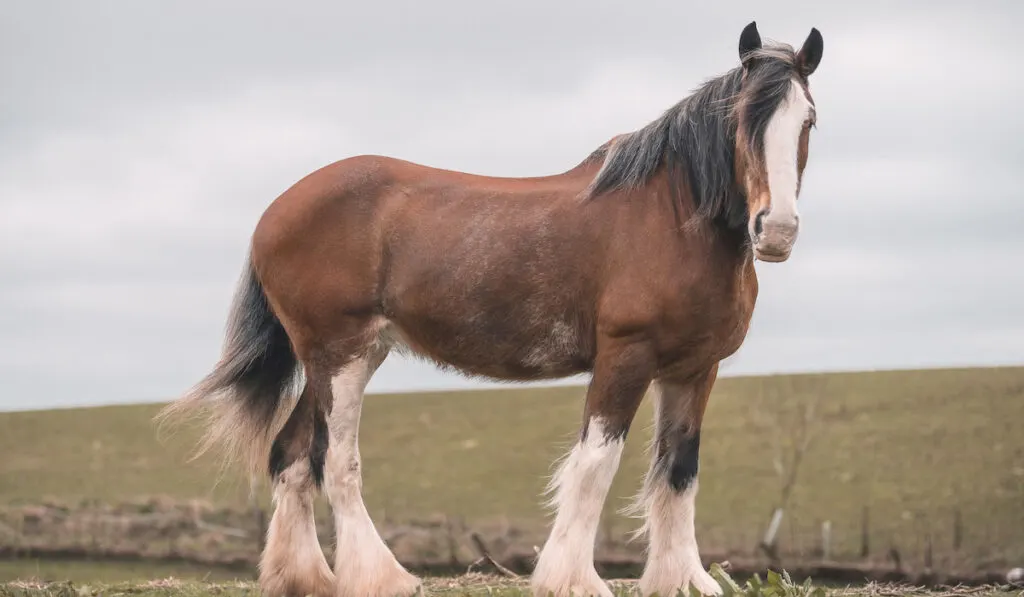
Draft horses come in a wide variety of size, type, and even color. These are just a few of the most popular draft horse breeds.
- Clydesdale Horse. If you have seen a Budweiser Brewing Company commercial, you have seen a Clydesdale horse. While this breed may be most well known for it’s appearance each year in iconic Super Bowl commercials, they are great to own as personal horses. These very versatile horses tend to be just as good at riding as they are at pulling carriages.
- Shire Horse. This big, beautiful draft horse breed is also well known for being the world’s largest horse. Samson, a Shire, stood 21.2 hands tall at the wither! Even so, they are well known for being a gentle giant.
- Percheron. Another gentle giant, the Percheron horse originated in the Perche region of France, near Normandy. They were originally bred as calvary horses by the French government. Today they are used for both driving and riding. They can even sometimes be seen in the dressage show ring!
- Belgian. The Belgian horse made it’s way to America in the late 1800’s and is commonly used on the farm for pulling equipment. They do, however, make excellent riding and driving horses as well. Easily spotted, the most common color for the breed is chestnut or sorrel with a flaxen (white) mane and tail.
- Ardennes. The Ardennes draft horse isn’t as common in America but, the breed itself has become more popular after it was included as a mount in the popular game, Red Dead Redemption 2. These cold-blooded draft horses are considered to be medium-sized and typically stand between 15 – 16 hands tall. While that may seem large enough, a 15 hand Ardennes draft horse would stand a full two feet shorter than the world record holder Samson the Shire!
Warmblood Horses
What is a warmblood horse?
Warmbloods are, as you may have guessed, the result of breeding a hot-blooded breed to a cold-blooded one. This results in a more standard-sized horse, thanks to the hot blood genes, but with a more level head and generally calm demeanor, thanks to the cold blood genes.
They are considered to be a middle-weight horse, similar to their hot-blooded counterparts – bigger than a pony, but smaller than a draft.
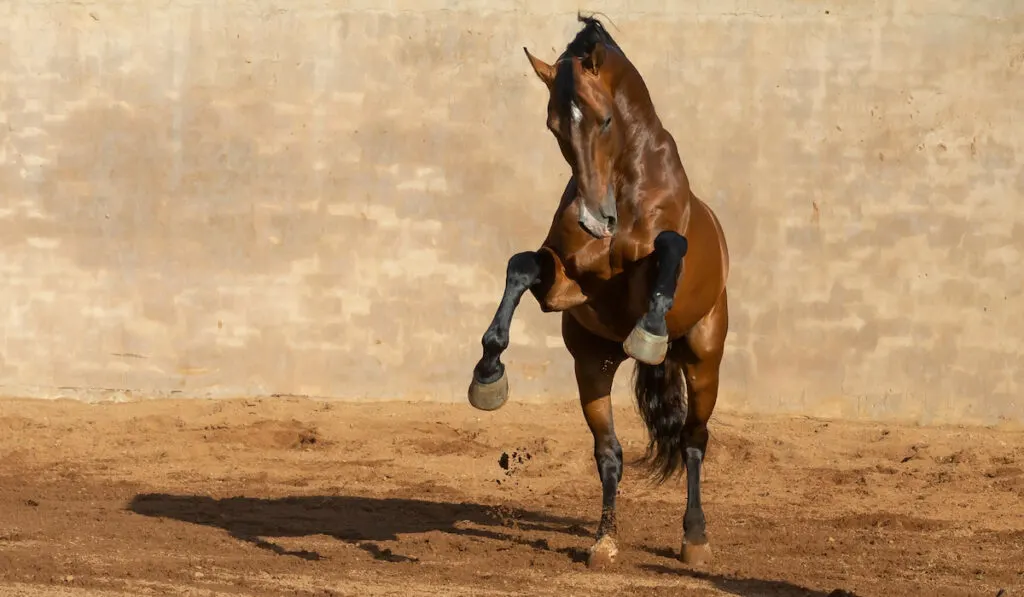
Warmblooded Horse Temperament
Since warmbloods are generally calmer than hot-bloods, but also more inclined for speed and agility than cold-bloods, they are considered excellent horses for anyone, from beginners to competitive riders.
You will often see them especially in eventing and dressage, where patience and a “slow down and think about it” stamina are necessary.
Essentially, warmblood horses inherit athletic ability from their hot-blooded side and balance it perfectly with the calm personality of their cold-blooded side.
Common Warmblooded Horse Breeds
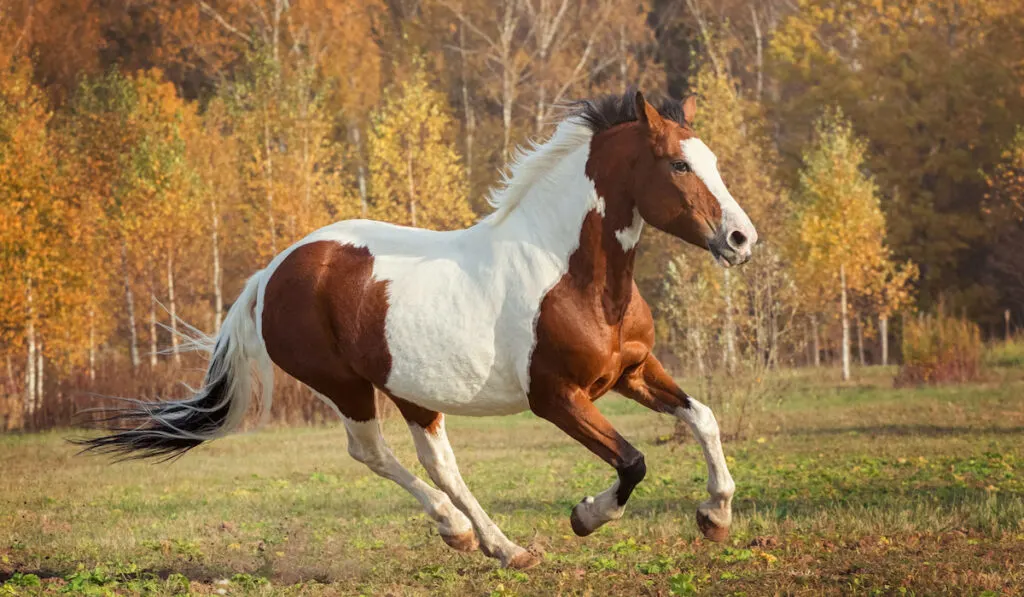
When most people think of warmblood horses, they think of the beautiful breeds of horse often seen in the show-jumping and dressage arenas. While these are, often, warmbloods, the reality is that any non-draft, non hot-blood breed is technically a warmblood. This includes ponies and most light horses.
Here are a few breeds of horses that are technically considered warmbloods, even though they are not commonly referred to as such.
- Quarter Horse. This common stock horse breed is the preferred mount of many cowboys. Originally developed to be ranch horses by day and racehorses by night, today the American Quarter Horse excels in almost every discipline.
- Paint Horse. When the quarter horse breed was being formed, it’s founding members excluded horses with high white markings. Not to be discouraged, those who preferred a more colorful ranch horse founded the American Paint Horse Breed. While their origins may slightly different, the Paint Horse is just as versatile as any Quarter Horse.
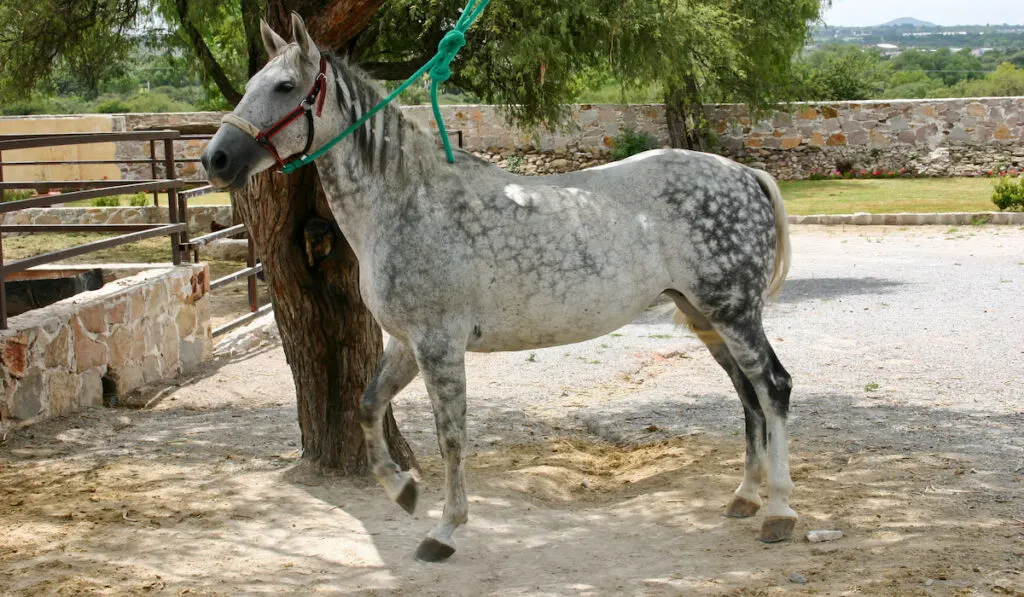
- Azteca. The Azteca horse is typically a cross between a purebred Andalusian or Lusitano and an approved outcross breed, most commonly the Quarter Horse. Azteca horses are typically well mannered, easily trained and extremely athletic.
- National Show Horse. This gorgeous gaited horse is a cross between the hot-blooded Arabian and the warmblooded American Standardbred. The resulting cross, a National Show Horse, excels in competition, much as it’s name suggests.
- Hannoverian. The Hannoverian horse is one of the more common breeds to be thought of as a warmblood horse. This horse may have begun as a coach horse during the Holy Roman Empire but the dressage and show jumping arenas are where they excel today.
- Morgan. The Morgan horse breed originated in America, Vermont to be exact. This entire type of horse was founded by one bay stallion named “Figure”. Today Morgan horses excel in almost every discipline and are very popular due to their athleticism and great dispositions.
Light Horses
Definition of a Light Horse
“Light horse” is a categorization that describes most of the more common breeds today. As the name suggests, they are bred predominantly for light work, such as harness work and riding.
It is a larger definition that encompasses pretty much any horse bred for that type of light work, and they are further classified by their type of light work training, such as stock type, hunter type, and saddle type. (source)
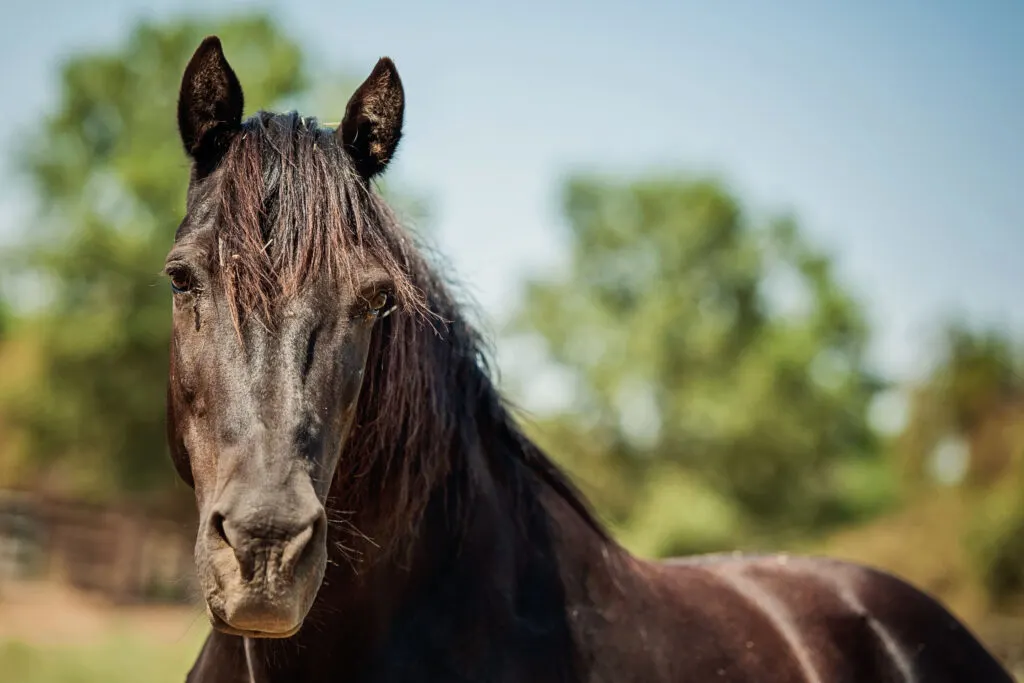
Since “light horse” embodies many of the warmblood and hot-blooded horses, but not ponies or drafts, they are typically over 14.2 hands and typically weigh anywhere from 900 pounds up to – or even exceeding – 1,500 pounds.
Temperament of Light Horses
Light horse breeds, since they are such a diverse group encompassing both warm and hot-bloods, inevitably vary in temperament and ancestry. They can be high strung and fiery, or more mellow and levelheaded.
Light horses are well suited for equestrian sports, from dressage to show jumping to racing. They are generally thought of as attentive and responsive and that temperament, coupled with their manageable size, can make them excellent family horses.
Others, though, may be more spirited and need a more experienced rider.

At the end of the day, a light horse is defined by its purpose, so personalities and physical looks can vary widely.
Common Light Horse Breeds
Within the “types” of horses, there is definitely some overlap. You see, while hot-blood and cold-blooded horses are mutually exclusive, it is possible to have both hot-blooded and warmblooded horses in the ‘light horse’ category.
Here are some common light horse breeds.
- Arabian. We’ve seen this one before in the hot-blooded category but the Arabian horse is also considered a light horse. Designed for endurance and stamina, this breed isn’t meant to work a field all day and that is how it arrives in this category.
- Thoroughbred. Just like the Arabian, the Thoroughbred is yet another hot-blooded horse that winds up in the light horse category. It makes sense if you think about the sleek, stream-lined physique of a racehorse.
- Andalusian. This one is new to the breed list but it is most definitely a light horse. While you may know Andalusian horses to be wider bodied and taller members of the equine family, they still fall into the light horse category.
- Morgan Horse. All horse owners know that “Justin Morgan had a horse”. That horse, Figure, was the founding sire of the Morgan breed. Known to be highly trainable and excellent with children, the Morgan horse is one of the many breeds that falls into the light horse category.
- Appaloosa. If you are looking for a spotted horse breed, no doubt you have heard of the Appaloosa horse. Because this breed was primarily founded for color, the physical appearance of this type of horse can vary widely from one member to another. One hallmark of them all, however, is that almost all appaloosa horses have beautiful spotting patterns.
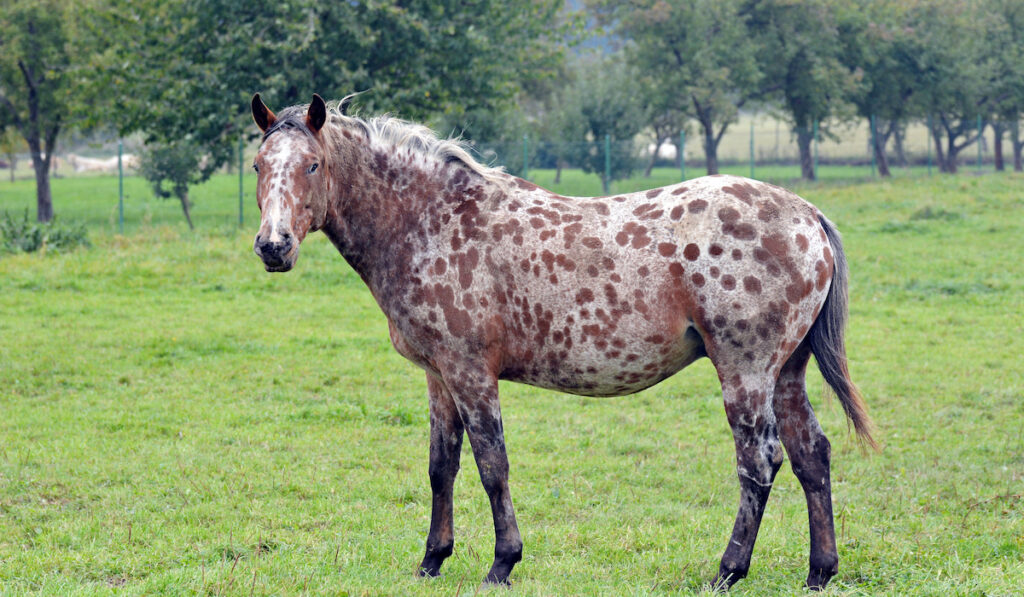
Horse Hybrids
The last category, or type of horse, isn’t actually a horse at all. This final horse type is reserved for horse hybrids. These are equines who have a horse as a parent and either a zebra or a donkey for the other parent.
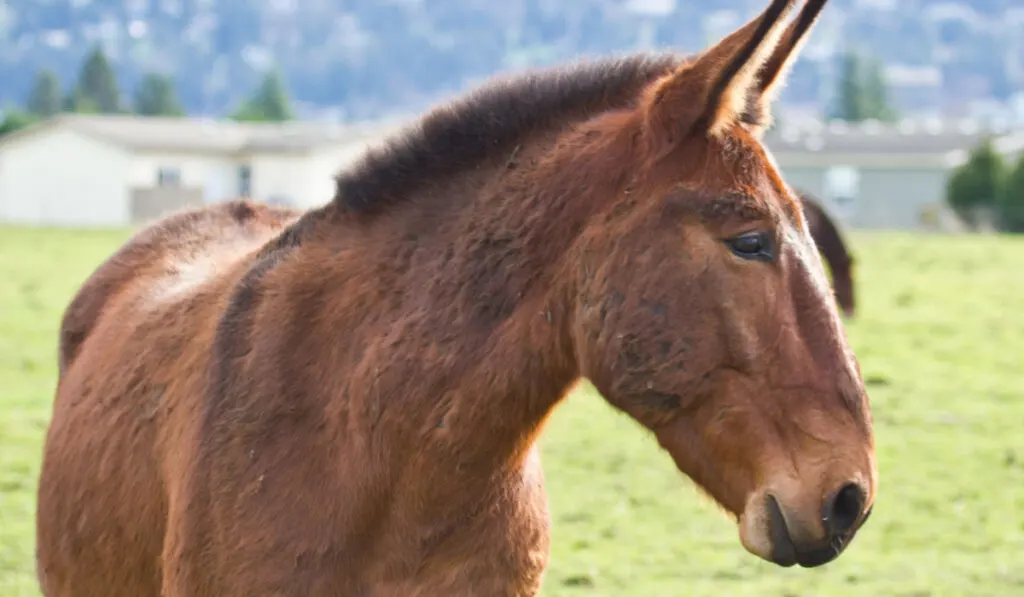
There are two types of equine hybrids and they have four different names depending on which species is the sire and which is the dam. Here is a helpful chart.
| Name of Hybrid | Sire | Dam |
| Zorse | Zebra | Horse |
| Zinny | Horse | Zebra |
| Mule | Donkey | Horse |
| Hinny | Horse | Donkey |
In all cases, the resulting hybrid is typically sterile, though there have been some exceptions in the case of mules.
For more insight on that check out my post on mules who have reproduced.
Zebra / Horse Hybrids
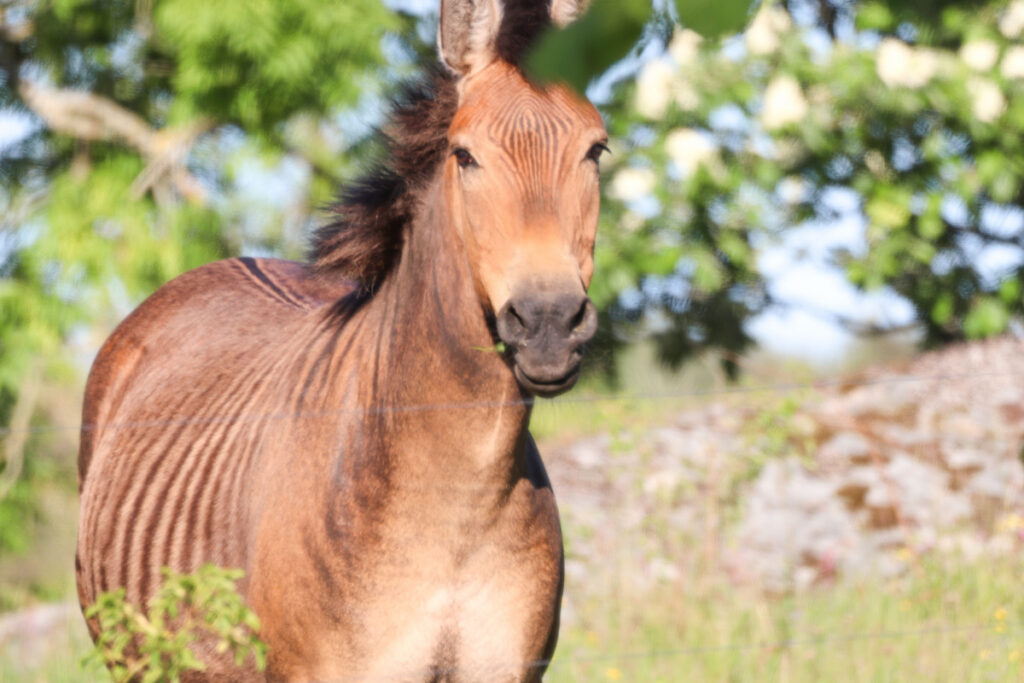
When it comes to crossing a zebra with a horse, the most typical cross is to breed a Zebra stallion to a female horse. The resulting offspring is called a zorse.
A zorse foal will inherit the color from the mare, and the stripes from the zebra. It is possible for a zorse to be pretty much any color, except double dilute colors like perlino, cremello and pearl.
Zebra hybrids tend to inherit a lot of the behavioral tendencies from their zebra parent. That means that the resulting foal, whether a Zorse or a Zinny, may be more aggressive and dangerous than a horse or mule.
While zebra/horse hybrids are fun to look at, they are best kept as pasture pets and only very experienced horsemen should try to teach them to ride or drive.
Horse / Donkey Hybrids
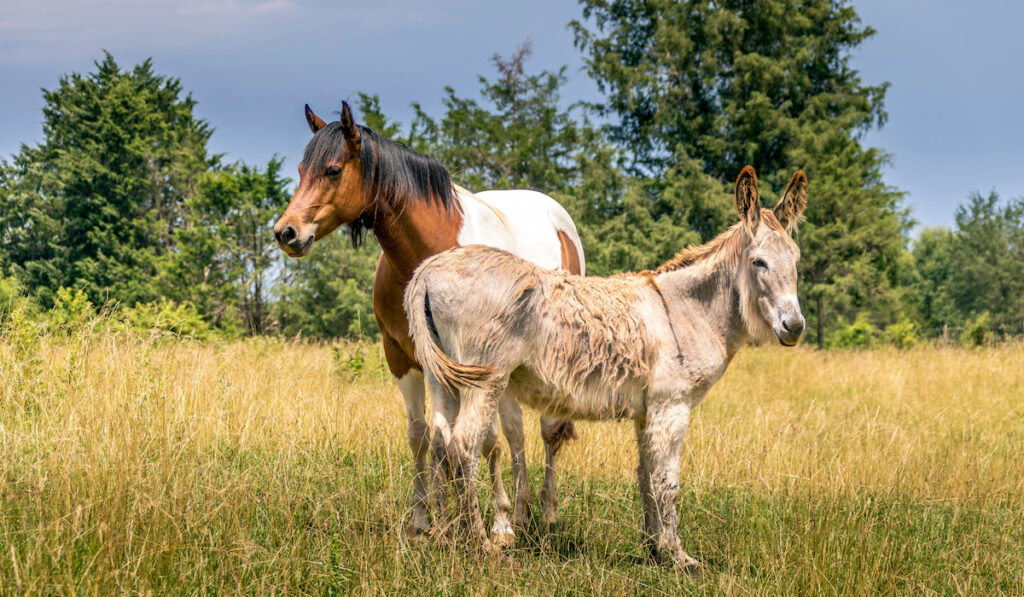
Horse / donkey hybrids, most commonly referred to as mules, are extremely popular in the United States as well as other horse-owning countries.
The mule is typically very hardy and a very good working companion. In fact, many cowboys prefer to ride a mule over a horse. That being said, they are known to require a different training approach than a horse.
Mule Size
A mule can be any size, from miniature all the way to draft. The size of the mule is typically determined by the size of the jack and the size of the mare he is bred to.
A miniature jack bred to a miniature horse mare produces a mule foal. Likewise, a mammoth jack bred to a draft horse mare will produce a draft mule.
Most common riding mules are the result of a mammoth jack bred to any mare from the light horse category.
Mule Temperament
There is an old saying that says:
You can tell a horse but you must ask a mule.
If you’ve heard the phrase stubborn as a mule it’s because a mule doesn’t just go along with a rider’s wishes. They need to have trust in their rider and have trust in their situation. In the right hands, a mule makes a wonderful riding and driving mount.
Most commonly, male donkeys (jacks) are bred to female horses (mares) to produce mules. Sometimes, though, a stallion breeds a jennet (female donkey). The result of that cross is a hinny.
Be sure to check out my article about hinny’s vs. mules for some fun facts about the differences between the two.
Final Thoughts
There are many different types of horses and this post has just covered, in detail, the seven most common. Within these types, there is a big possibility for overlap. In general, these classifications are just a way for horse enthusiasts to group horses into a “bucket” for generalization of appearance and temperament.
The reality is, no matter what type of horse you have, there are always horses that don’t fit the mold. There are super calm Arabians, super high-strung Quarter horses. There are draft horses that are short and there are light horses that are extremely tall.
It’s great to be knowledgeable about the different horse types but remember to not get too hung up on “technicalities”. Just enjoy horses (and hybrids) for who they are as individuals, not what bucket they fall into.

